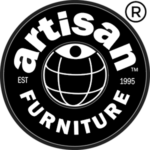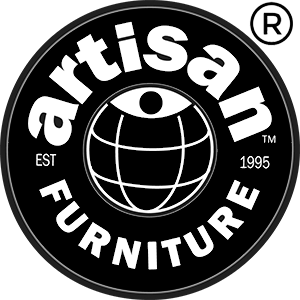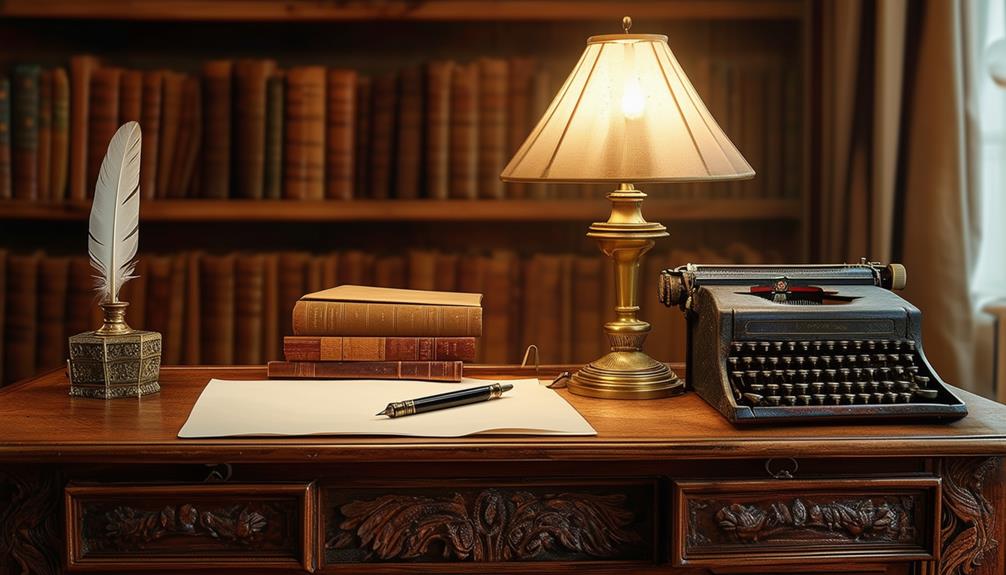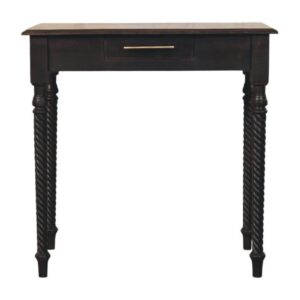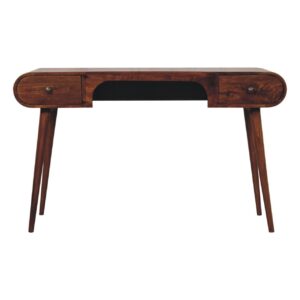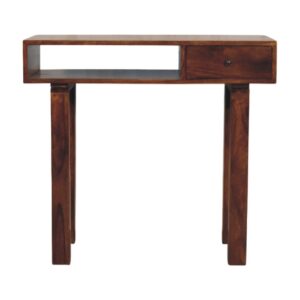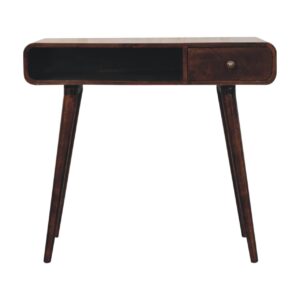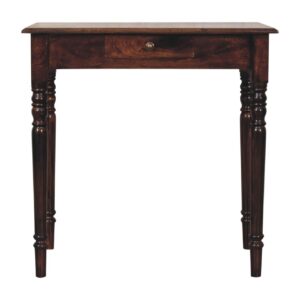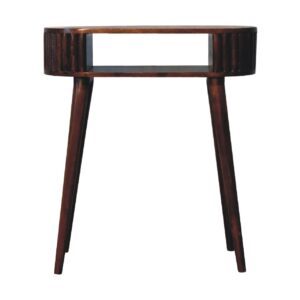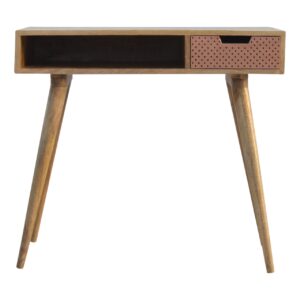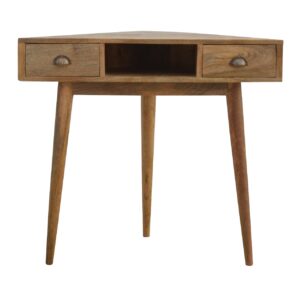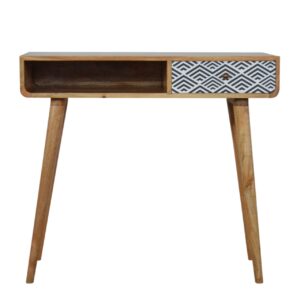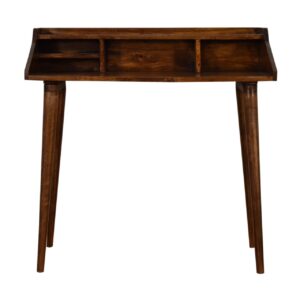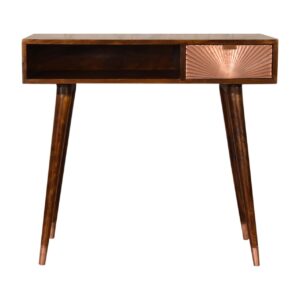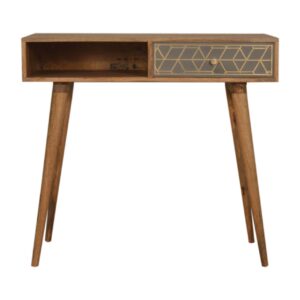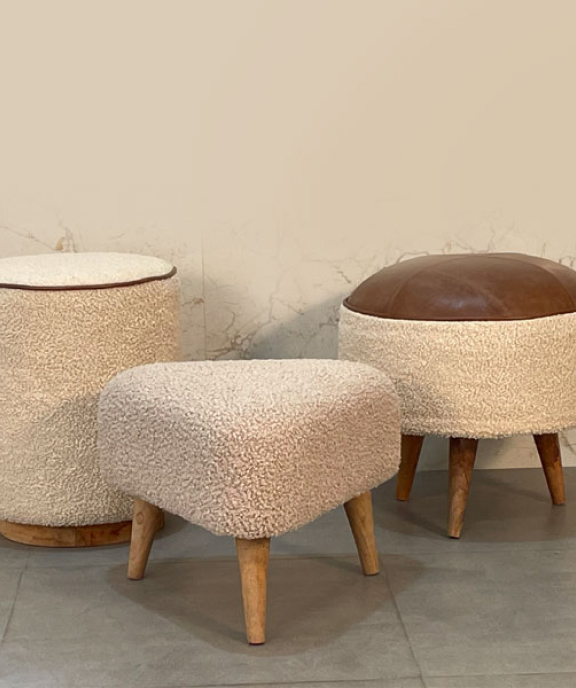Writing desk tables are versatile pieces of furniture designed for work, study, and creative pursuits. We've found that they come in various styles, from modern and adjustable to traditional and wall-mounted options. These desks are typically constructed from durable materials like Sheesham, Mango, or engineered wood, often featuring metal accents for added strength. Ergonomic factors, such as adjustable heights and inclined surfaces, enhance comfort during extended use. Many designs incorporate space-saving features and integrated storage solutions to maximize functionality in limited areas. When selecting a writing desk, it's vital to evaluate size, style, and ergonomic features to guarantee it meets specific needs and complements the existing decor. Further exploration reveals additional insights into ideal desk selection and maintenance.
Types of Writing Desk Tables
Writing desk tables come in a variety of styles to suit different needs and spaces, from modern and adjustable designs to traditional and space-saving options.
We've observed that modern writing tables often feature compact and functional designs, with some offering foldable options for versatility in smaller spaces. These contemporary designs prioritize efficiency and adaptability to meet the demands of today's dynamic work environments.
For those seeking ergonomic comfort, we've found that adjustable writing tables are an excellent choice. These tables provide height and angle adjustments, allowing users to customize their workspace to their preferences and physical needs. This adaptability can greatly enhance comfort during extended periods of use.
We've also noted the enduring appeal of traditional writing tables, which showcase vintage aesthetics while incorporating multifunctional features. These tables blend classic style with practical utility, often including built-in storage options.
For those with limited space, we recommend considering wall-mounted writing tables. These space-saving designs offer a sturdy work surface without occupying valuable floor area, making them ideal for children's rooms or compact home offices.
Materials and Construction
While the style and type of writing desk are important considerations, the materials and construction of these tables play a key role in their durability, functionality, and overall appeal. We often see writing desks crafted from a variety of materials, each offering unique benefits. Sheesham wood, for instance, is prized for its durability and distinctive grain patterns, while engineered wood provides a cost-effective and versatile alternative.
For those seeking robust construction and resistance to warping, solid wood options like Mango and Teak are excellent choices. In modern designs, we frequently encounter metal finishes combined with wooden elements, adding strength and a contemporary aesthetic.
| Material | Characteristics |
|---|---|
| Sheesham Wood | Durable, unique grain patterns |
| Engineered Wood | Cost-effective, versatile |
| Mango Wood | Robust, resistant to warping |
| Teak Wood | Long-lasting, solid construction |
| Metal Finishes | Strong, contemporary aesthetic |
The construction of writing desks often features heavy-duty components to guarantee stability and longevity. We typically find desk surface thicknesses ranging from 12MM to 25MM, with thicker tops providing greater durability and support for heavier items. This attention to detail in materials and construction results in writing desks that are not only functional but built to last.
Ergonomics and Comfort
Ergonomics and comfort play an essential role in the design of modern writing desks, ensuring users can work efficiently without compromising their health. We've observed that many contemporary desks incorporate adjustable height features, allowing individuals to customize their workspace to their preferred sitting or standing position. This adaptability considerably reduces strain on the back and neck, promoting better posture and overall well-being.
We've found that ergonomic designs often include inclined surfaces, which enhance reading and writing posture. These thoughtful inclinations facilitate a more natural alignment of the spine, effectively reducing fatigue during extended study or work sessions. Additionally, we've noted that well-designed writing desks provide ample legroom and space for movement, ensuring proper circulation and comfort during prolonged periods of use.
In our research, we've identified that attention to detail in desk construction, such as rounded edges and soft finishes, helps minimize discomfort and prevent injuries from sharp corners. Moreover, studies have shown that investing in ergonomic furniture, including well-designed writing desks, can greatly improve productivity and focus.
We believe this contribution to a healthier work or study environment is a vital factor in the evolving design of writing desks.
Space-Saving Designs
Space constraints have driven the evolution of writing desk designs, leading to innovative solutions that maximize functionality in minimal square footage.
We've seen a surge in wall-mounted writing desks that fold away when not in use, providing an excellent space-saving option for small rooms or home offices. These compact designs, like the Holger Foldable Wall Mounted Table, measure just a few inches in depth when folded, making them ideal for tight spaces.
For those seeking multi-purpose solutions, we've observed an increase in study tables with integrated shelving. These designs efficiently utilize vertical space, offering additional storage for books and supplies while enhancing organization in limited areas.
We've also noted the popularity of adjustable height writing tables, which provide ergonomic options for users to adapt their workspace for sitting or standing positions.
To further address space limitations, we've identified three key trends in writing desk design:
- Wall-mounted folding desks
- Multi-functional designs with built-in storage
- Portable, lightweight writing surfaces
These innovations allow users to create functional workspaces in various locations without sacrificing substantial floor space, making them ideal for modern, compact living environments.
Style and Aesthetic Considerations
Writing desks consistently blend form and function, offering a wide array of styles to suit diverse aesthetic preferences and interior design schemes.
We've observed that these essential pieces come in various styles, including modern, traditional, and contemporary, allowing individuals to select designs that complement their home or office decor. Popular aesthetic options range from sleek finishes in engineered wood to rich grains in Sheesham and Mango wood, as well as minimalist designs that enhance spaces without overwhelming them.
We've found that customizable features play an important role in tailoring writing desks to personal style and functional needs. Color choices and additional storage options allow users to create a desk that truly reflects their preferences.
Furthermore, we've noticed that ergonomic elements are often incorporated into the design, such as adjustable heights and angled surfaces, promoting comfort while maintaining a stylish appearance.
It's clear that a well-chosen writing desk serves not only a functional purpose but also acts as a focal point in a room, enhancing the overall ambiance and encouraging productivity. This dual role underscores the significance of carefully considering style and aesthetics when selecting a writing desk.
Storage Solutions
Beyond aesthetics, we've found that effective storage solutions are a key factor in choosing the ideal writing desk. Modern writing tables often come equipped with an array of storage options designed to enhance organization and maximize workspace efficiency. These features typically include drawers, shelves, and built-in compartments, allowing users to keep essential items readily accessible during work or study sessions.
We've observed that writing desks with integrated storage offer various benefits:
- Minimized clutter: Built-in storage helps maintain a tidy workspace by providing dedicated spaces for stationery, documents, and other supplies.
- Increased productivity: Easy access to necessary materials reduces time spent searching for items, allowing for more focused work sessions.
- Space optimization: Innovative storage solutions, such as wall-mounted writing tables, can provide ample storage without occupying valuable floor space.
Additionally, we've noted that adjustable writing tables often incorporate adaptable storage solutions, catering to diverse user needs. These versatile designs may include features like file drawers, pencil trays, and open shelves, accommodating a wide range of storage requirements for paper, books, and other work essentials.
This flexibility makes them suitable for students, professionals, and casual users alike.
Customization Options
In the domain of writing desk tables, we've found that customization options play an essential role in meeting individual needs and preferences. We've observed that many manufacturers offer a range of choices, allowing customers to tailor their desks to specific requirements. These options often include selecting the desk's size, material, and finish, ensuring that the final product aligns with the user's space constraints and aesthetic preferences.
We've noted that wood selection is a key customization feature, with choices such as Sheesham, Mango, and Acacia providing varied durability and visual appeal. Additionally, we've seen that ergonomic considerations are addressed through adjustable height features, which can greatly enhance user comfort.
For those seeking organizational solutions, we've found that customizable storage options, including drawers and shelves, are frequently available. Moreover, we've recognized that style customization is often possible, with buyers able to choose between modern, traditional, or contemporary designs to complement their existing decor.
These customization options, we've concluded, allow for a highly personalized writing desk that not only meets functional needs but also reflects individual taste and style preferences.
Maintenance and Care
While customization options enhance a writing desk's appeal, proper maintenance and care are key to preserving its beauty and functionality over time.
We recommend regularly dusting your desk with a soft, lint-free cloth to prevent dirt and grime buildup that can damage the finish. For wooden desks, we suggest using a mild soap solution followed by a damp cloth, ensuring you dry the surface immediately to avoid moisture damage.
To maintain your desk's longevity and appearance, consider these essential steps:
- Apply a quality wood polish or conditioner every few months to maintain shine and protect the wood from drying out and cracking.
- Use coasters or placemats to prevent heat and moisture damage from hot or wet items placed directly on the desk surface.
- Position the desk away from direct sunlight to prevent fading and warping of the material over time.
Choosing the Right Size
When it comes to selecting a writing desk, size matters greatly for both comfort and functionality. We need to carefully consider the dimensions of our available space, making sure we leave at least 60-75 cm of clearance for movement and additional furniture. This allows us to create a comfortable work environment without feeling cramped.
Standard writing desk heights typically range from 71 to 76 cm, so we must choose a size that allows for comfortable seating and ideal posture while working. As for width, we'll find that desk sizes can vary greatly. Compact models measure around 90 cm, while larger desks can extend up to 180 cm or more, accommodating multiple users or extensive work setups.
For those of us with limited space, wall-mounted writing tables or foldable designs offer functional work areas without occupying excessive floor space. It's essential that we measure our equipment, such as laptops or monitors, and add extra space for writing materials to guarantee the desk provides adequate surface area for all our needs.
